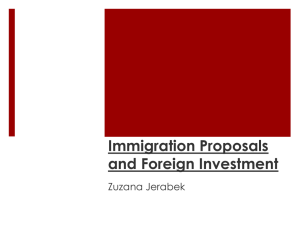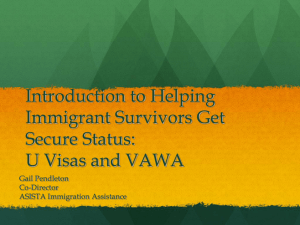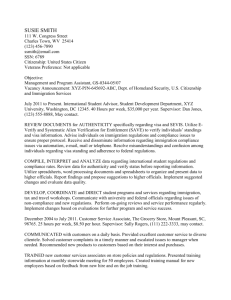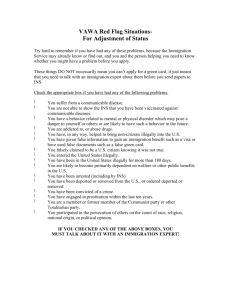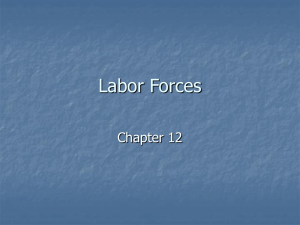VAWA and U presentation 2009 8 14
advertisement
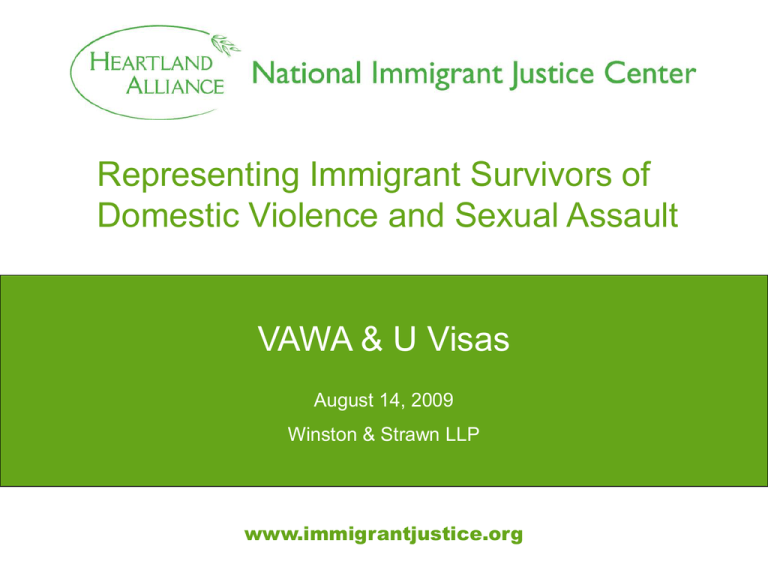
Representing Immigrant Survivors of Domestic Violence and Sexual Assault VAWA & U Visas August 14, 2009 Winston & Strawn LLP www.immigrantjustice.org About the National Immigrant Justice Center The National Immigrant Justice Center (NIJC), a program of Heartland Alliance for Human Needs & Human Rights, promotes human rights and access to justice for immigrants, refugees, and asylum seekers through legal services, policy reform, impact litigation, and public education. Throughout its 30-year history, NIJC has been unique in blending individual client advocacy with broad-based systemic change. • NIJC serves more than 8,000 immigrants annually with the support of a professional legal staff and a network of over 1,000 pro bono attorneys. • NIJC maintains a 90 percent success rate in representing asylum seekers. • Since 2004, NIJC has litigated over 100 due process and asylum cases in the federal courts in conjunction with pro bono attorneys. • In FY 2007, NIJC successfully represented 24 individuals seeking protection in the United States before the U.S. Seventh Circuit Court of Appeals. NIJC’s Pro Bono Projects What we do: Case screening, assessment and acceptance Placement with pro bono attorneys Case management Attorney support and technical assistance Pro Bono Opportunities with NIJC Asylum Detention SIJS VAWA & U-visas Citizenship I-730s & Asylee Adjustments Pro Bono Case Assignment Process List of available cases, with brief description, sent out to our pro bono attorney network bi-monthly Conflicts Check Case Assignment NIJC remains “of counsel” NIJC provides on-going support and assistance Pro bono attorney will set-up initial interview with client within 1-2 weeks of case assignment Applications should be filed as soon as possible (8-12 weeks recommended preparation and filing time) Pro bono attorney remains attorney of record throughout duration of case If pro bono attorney cannot continue with case, must make efforts to reassign internally and notify NIJC Interviewing Your Client Find volunteer interpreter, if necessary Safety check Stress confidentiality Refer to counseling or other services, as needed Sign Release of Information and Retainer Agreement Build a relationship of trust Physical and emotional space Avoid legalese Learn about client's family, and immigration and criminal history (i.e. prior marriages, children or other family members living in U.S., criminal history, entries/exits in the U.S., prior immigration applications filed or problems with immigration) Explain domestic violence using P&C wheel Explain application process, fees/fee waivers and processing times Review list of documents that will be needed for filing The Cycle of Abuse The Honeymoon Denial Explosion TensionBuilding Domestic Violence Tactics Used by Abusers to Exert Power and Control Emotional Abuse Isolation Intimidation Economic Abuse Power And Control Using Citizenship or Residency Privilege Sexual Abuse Physical Abuse Threats How Abusers Can Misuse Immigration Privilege Failing to file immigration papers on behalf of family member Filing an I-130 petition (or other application) and later withdrawing it Threatening to contact immigration officials Contacting immigration officials for the purpose of reporting family members Providing immigration officials with false information about family members Cultural Barriers Facing Immigrants Language limitations Extreme Isolation Cultural ideas of family shame and honor Close-knit communities Role of religion Basic Overview of Family Based Immigration Obtaining lawful permanent residence through family members Grounds of inadmissibility Waivers of grounds of inadmissibility Family based immigration and domestic violence Laws and Reference Sources Immigration & Nationality Act (Title 8 of U.S. Code) Title 8 of Code of Federal Regulations Agency Policy Memoranda and Guidance Board of Immigration Appeals (BIA) and Federal Circuit Case Law Kurzban’s Immigration Law Sourcebook USCIS website (www.uscis.gov) American Immigration Lawyers Association (AILA) ILRC NLG/NIP Asista Terms and Acronyms DV: domestic violence LPR: lawful permanent resident “green card” USC: US citizen EWI: entry without inspection VAWA: Violence Against Women Act U Visa: visa for victims of certain crimes AOS: Adjustment of Status - the process applying for LPR (in the U.S) Consular Processing: applying for LPR (outside of the U.S.) USCIS & DHS. U.S. Citizenship & Immigration Services was created as part of the Department of Homeland Security in 2002 (former INS) RFE: Request for Evidence PRD: Priority Date EOIR: Executive Office for Immigration Review IJ: Immigration Judge ICE: Immigration and Customs Enforcement CBP: Customs & Border Protection EAD: Employment Authorization Document (“work permit”) DA: Deferred Action Family Preference System v. Immediate Relatives LPRs can petition for certain relatives. Due to limits placed on the number of visas available to such beneficiaries, persons who are not immediate relatives must wait to apply for LPR status. The waiting time depends on the status of the petitioner and the type of relationship between the petitioner and beneficiary. Department of State Visa Bulletin: www.state.gov/travel Obtaining Lawful Permanent Residency through FamilyBased Petition U.S. citizens can petition for: Parents = immediate relative Spouses = immediate relative Children (under 21/unmarried) = immediate relative Adult, married children Siblings LPRs can petition for: Spouses Unmarried children Applying for Lawful Permanent Residence Two-Step Process Step 1: filing a visa petition form (Form I-130) Step 2: applying for an adjustment of status (Form I-485) STEP 1: Filing an I-130 Petition for Alien Relative (Priority Date) If the beneficiary is an immediate relative can usually take both steps together When the I-130 is approved, a PRD is set. The PRD is usually the same as the date on which I-130 was received by USCIS. The PRD establishes the date on which an applicant can take the second step and apply to adjust to LPR status. STEP 2: Filing Form I-485 Application for Lawful Permanent Residence Once an individual has an approved visa petition or current priority date, she can apply to adjust her status in the United States If a person cannot adjust status to lawful permanent residence in the United States, she may consular process in her home country INA § 212(a) and Grounds of Inadmissibility Health-related grounds Criminal and related grounds Security and related grounds Public charge Illegal entrants and immigration violators False claim to U.S. citizenship Persons previously removed Aliens unlawfully present Waivers for Grounds of Inadmissibility There are waivers available for several grounds of inadmissibility Under VAWA, applicants can obtain special waivers for certain (but NOT ALL) grounds of inadmissibility Under U Visa, applicants can obtain waivers for almost all grounds of inadmissibility The Violence Against Women Act (VAWA) The Violence Against Women Act was signed into law by President Clinton in 1994 as part of a larger crime bill to address domestic violence, sexual assault and stalking VAWA was amended in 2000 and 2005. VAWA includes special provisions for battered immigrants that allows them to gain legal immigration status without relying on their abusive US citizen or LPR spouses or parents INA § 204; 8 CFR 204 VAWA Process Affirmatively –selfpetition before USCIS Defensively – adjustment of status based on VAWA or cancellation of removal before Immigration Court Who Is Eligible to Self-Petition Under VAWA? Abused spouses of U.S. citizens and LPRs; Non-abused spouses of US citizens or LPRs whose children are abused (need not be children of abuser); Abused children (must meet the definition of a “child” under INA § 101(b)) of USCs or LPRs; Abused children of USCs may file until age 25 if central reason for delay is abuse (VAWA 2005); Abused intended spouses, meaning a spouse who entered into a bigamous marriage in good faith. See INA § 204(a); Abused parents of USC children (VAWA 2005) Special VAWA Provisions An immigrant is still eligible to self-petition within two years following the occurrence of the following events: Death of USC (Not LPR) Divorce Deportation where there is a connection to the domestic violence Self-Petitioners Must Prove Status of Abuser (USC or LPR) Marriage Requirements Legal Marriage Good Faith Marriage Battery or extreme cruelty Residency Requirements Self-petitioner lived with abuser Self-petitioner’s current residence Good Moral Character (3 years prior) See INA § 204 Standard of Proof “Any credible evidence” standard applied to VAWA self-petitions 8 CFR § 204.2(c)(2)(i) Client Affidavit Ok for client to write in her own in native language and translate Can have client prepare with counselor or other advocate Take what client wrote and organize in chronological order Fill in important details Must be comprehensive and address all eligibility requirements Abuser’s Immigration Status U.S. birth certificate U.S. passport Resident Alien Card Application for Marriage License Child’s birth certificate Request to search service records (if abuser legalized his or her status with USCIS) Good Faith Marriage Self-petitioner cannot have entered into a marriage for the primary purpose of circumventing the immigration laws. 8 CFR § 204.2(c)(1)(ix). KEY FACTOR is whether she intended to establish a life with spouse at the time of marriage. Battery or Extreme Cruelty Is defined broadly to include “being the victim of any act or threatened act of violence, including any forceful detention, which results or threatens to result in physical or mental injury.” 8 CFR § 204.2(c)(2)(vi). See Hernandez v. Ashcroft, 345 F.3d 824 (9th Cir. 2003) for thorough legal analysis of what constitutes “extreme cruelty.” Good Moral Character Must establish good moral character for the three years preceding the filing of the self-petition See 8 CFR 204.2(c)(1)(vii) and (c)(2)(v). See INA § 101(f) Confidentiality Provisions Section 384 of the Illegal Immigration Reform and Immigrant Responsibility Act (IIRIRA) of 1996 prohibits all DHS and DOJ employees from providing information about a self-petitioner to 3rd parties Section 384 similarly prohibits DHS from making any decisions about removability based solely on information provided by the abuser 8 CFR § 1367 Filing Fees Form I-360 ($0) Form I-765 without adjustment ($340) Form I-485 ($1010 14 years or $930 under 14 years or if filing with one adult/parent, then $600) All fees should be in form of money order and payable to “Department of Homeland Security” Fee waiver request should be in form of notarized client affidavit demonstrating “inability to pay” and include evidence of income/expenses Filing Procedures for VAWA Self-Petitioners File necessary applications and supporting evidence: Detailed, argumentative cover letter & index of documents G-28, Notice of Representation Form I-360 (self-petition) with evidence supporting all requirements Form I-765 (employment authorization – if eligible to adjust, otherwise, must wait until VAWA is approved) Two passport photos if filing I-765 Form I-485 (adjustment application) Two passport photos if filing I-485 G-325A, Biographic Information I-693, Medical Exam I-864W, Affidavit of Support Exemption Fee Waiver Request, if applicable Filing Tips … *Derivatives* All foreign documents must be translated. Translator must certify that he/she is competent in both languages to render an accurate translation Two-hole punch at top of application packet and bind with metal prong fasteners or binder clip DO NOT use spiral binding Place each application (I-360, I-485 & I-765) into a separate envelope Write in large red letters 1) the type of application, 2) VAWA, and 3) “with fee waiver request” (if applicable) Place all envelopes into one mailing envelope Send via certified mail or overnight delivery Where to File • Self-petition and all accompanying applications are sent to: USCIS Vermont Service Center Attn: VAWA Unit 75 Lower Welden Street St. Albans, VT 05479-0001 After Filing the Self-Petition You will receive Form I-797, Notice of Action, indicating Receipt of your filing within about 2 weeks. You will receive Form I-797, Notice of Action, indicating establishment of a prima facie case. You will not hear anything else for approximately 10 months. Prima Facie Notice It is NOT an approval notice It may be used to obtain public benefits U.S. Department of Justice Bureau of Citizenship and Immigration Services RECEIPT NUMBER EAC-99-000-99999 CASE TYPE I-360 Petition for Amerasian, Widow(er), or Special Immigrant Petitioner Ochoa, Graciela Ochoa, Graciela NOTICE DATE PAGE February 21, 1999 1 of 1 RECEIPT DATE March 2, 1998 FILE NUMBER A76 000 999 Self-Petitioning Spouse of U.S.C. or L.P.R. Attn: Sherizaan Minwalla ESQ Midwest Immigrant and Human Rights Center 208 S. LaSalle, Suite 1818 ESTABLISHMENT OF PRIMA FACE CASE Outcomes of Self-Petition Request for Evidence (RFE) Approval Notice of Intent to Deny (NOID) Denial I-360 Approval and Deferred Action Deferred Action initially valid for 15 months and renewable in 12-month increments Low priority for removal from the United States Legal basis for employment authorization If I-485 was concurrently filed with I-360, application will be transferred to local district office for scheduling of interview and adjudication Employment Authorization You can file for employment authorization once the VAWA self-petition has been approved; or You can file employment authorization if filing an I-485 with the VAWA self-petition Employment Authorization may be renewed annually, provided there is still a legal basis for eligibility See 8 C.F.R. 274a.12 Adjustment of Status Interview Purpose – To adjudicate I-485 and determine admissibility Officer does not have authority to re-adjudicate I-360 or question validity of decision What to bring Originals with translations (birth certificates, marriage certificates) Passport of I-94 (only if client has these) Govt. issued form of photo identification All prior work permits Translator (non-relative, over age 18, with photo ID) Sample VAWA Case Maria is a 32 year old Mexican citizen who entered the United States without inspection in 1997. She has not left the U.S. since entering at that time. In 2002, Maria married Alberto who is an LPR, and together they have two U.S. citizen children. Maria also has another child from a previous relationship who was born in Mexico. Maria’s husband was physically and verbally abusive throughout their marriage. Alberto always threatened her with calling immigration and never filed any papers for her. In December of 2008, Maria obtained an order of protection and moved into a domestic violence shelter. Maria is now seeking a divorce. History of U Visa The U Visa for non-citizen victims of crime was created in October 2000 as part of the Victims of Trafficking and Violence Prevention Act “VTVPA” See INA § 101(a)(15)(U) Alien victims may not have legal status and, therefore may be reluctant to help in the investigation or prosecution of criminal activity for fear of removal from the United States. The U visa was created to strengthen the ability of law enforcement agencies to investigate and prosecute cases of domestic violence, sexual assault, trafficking of aliens and other crimes while offering protection to victims of such crimes. Provides a mechanism to remain in the U.S. to assist in an investigation/prosecution of those who have perpetrated crimes against them. Legal Basis Victims of Trafficking and Violence Protection Act, Pub. L. 106-386, October 28, 2000 INA § 101(a)(15)(U) 8 CFR § 214.14 Trafficking Victims Protection Reauthorization Act, Pub. L. 108-193 Violence Against Women and Department of Justice Reauthorization Act, Pub. L. 109-162, January 5, 2006 U Interim Relief Regulations implementing the U nonimmigrant status provisions of the INA were not published until September 2007. Before the regulations were published, USCIS established a program to provide interim relief to those who appeared to be eligible for U nonimmigrant status; this was in the form of deferred action and employment authorization. Between October 28, 2000 (date of enactment for VTVPA) and October 17, 2007 (effective date of U visa regulations), USCIS granted 10,846 individuals interim relief. Benefits & Limitations Can apply for adjustment after 3 years in U nonimmigrant status Annual cap of 10,000 per fiscal year Can apply for family members. Derivative Relationship must exist at the time I-918 filed, at time adjudicated, and at time of admission. *Exception: Qualifying family members who were granted interim relief may use their age on the date of the U interim relief filing to prove eligibility http://www.uscis.gov/files/pressrelease/AFMUpd ate_Ch39.pdf Victim prohibited from petitioning for derivative U status for family member who committed battery, extreme cruelty or trafficking against victim which established eligibility for U status U Visa Requirements Immigrant suffered substantial mental or physical abuse as a result of having been a victim of certain criminal activity; and Immigrant (or in the case of a child under 16, the parent or guardian) possesses information concerning that criminal activity; and The criminal activity violated U.S. law or occurred in the U.S.; and The immigrant has been helpful, is being helpful, or is likely to be helpful to a Federal, State or local authority investigating or prosecuting the crime INA § 101(a)(15)(U); 8 CFR § 214.14 *Any credible evidence standard applies Qualifying Criminal Activity Involves one or more of the following or any similar activity in violation of Federal, State, or local criminal law: Rape Torture Trafficking Incest Domestic Violence Sexual Assault Abusive Sexual Contact Prostitution Sexual Exploitation Female Genital Mutilation Being Held Hostage Peonage Involuntary Servitude Slave Trade Kidnapping Abduction Unlawful Criminal Restraint False Imprisonment Blackmail Extortion Manslaughter Murder Felonious Assault Witness Tampering Obstruction of Justice Perjury • Includes attempts, conspiracy, or solicitation to commit any of the above. U Visa Certification (Form I-918, Supplement B) Certification required Must be completed and signed by the head of the certifying agency or any person specifically designated by the head of the agency to sign such certifications, or a Federal, State, or local judge Certification must have been signed within 6 months immediately preceding the submission of the petition package Will not be conclusive evidence of any of the eligibility requirements. Victim who has suffered substantial physical or mental abuse as a result of qualifying criminal activity Not a list of specific statutory violations; list of general categories of criminal activity May occur during the commission of non-qualifying criminal activity (ex. Embezzlement investigation) Regulation states that any “similar activity” may be a qualifying crime. Applies to crimes where the nature and elements are substantially similar to the statutory list (e.x., sexual exploitation and video voyeurism) Applicant would need to provide evidence demonstrating how the criminal activity of which he/she is a victim is substantially similar to one of the listed crimes Definition of Victim Direct Victim Generally defined as one who is directly and proximately harmed by qualifying criminal activity Can include bystanders Those who witness violent crime and suffer unusually direct injury. (Ex. Pregnant woman who witnesses violent crime) Indirect Victim Criminal activity includes murder & manslaughter, obstruction, perjury, and witness tampering Direct victims are deceased in murder and manslaughter crimes, or are incompetent or incapacitated Obstruction, perjury and witness tampering are not crimes against a person Possession of Information Concerning the Qualifying Criminal Activity Must have knowledge of the details (specific facts) that would assist in the investigation or prosecution If victim less is than 16 years or incompetent/incapacitated, a parent, guardian, or next friend may possess info Look at age of victim on date qualifying criminal activity first occurred to determine whether exception triggered “Next Friend”: person who appears in a lawsuit to act for the benefit of an alien who is under 16 or incompetent or incapacitated; not a party to legal proceeding and not appointed guardian; cannot qualify for U visa on own simply on this basis Helpfulness in Investigation or Prosecution of Qualifying Criminal Activity Helpful means: assisting law enforcement in the investigation or prosecution of the qualifying criminal activity of which he/she is a victim Those who refuse to assist after reporting the crime are excluded from eligibility Requires an ongoing responsibility on the part of the petitioner to be helpful, assuming there is an ongoing need for the petitioner’s assistance Exception for those under 16 or incompetent/incapacitated; same as for possession of information requirement Criminal Activity that Violated U.S. Law or Occurred in the United States Violation of U.S. Laws – distinction is not based on which laws are violated (foreign or U.S.) but rather where the violation occurred; if the violation of U.S. laws occurred outside the U.S. and violates a federal statute that specifically provides for extraterritorial jurisdiction, it may be deemed to have “violated U.S. law” Generally requires a nexus between criminal activity and U.S. interests Example is sex tourism statute Prosecution does not need to occur as may be difficult to extradite defendant U Visa Derivatives If the victim is under 21 (at the time of filing): Parents Siblings under 18 at the time the application is filed If the victim is over 21 (at the time of filing): Spouses Unmarried children *Exception for those with U interim relief Inadmissibility An inadmissible principal or derivative petitioner is not eligible for U status unless waiver (Form I-192) is granted INA 212(d)(14) and INA § 212(d)(3) authorize waiver of all grounds found under INA § 212(a) (except 212(a)(3)(E) – participants in Nazi persecutions, genocide, acts of torture, or extrajudicial killing) if it is in the public or national interest Waiver request is made on Form I-192 which costs $545.00. Applicant may request waiver of this fee if can demonstrate “inability to pay.” See 8 CFR § 103.5(c)(5). Applicants in Removal Proceedings Alien in removal proceedings may seek agreement of ICE to file a joint motion to terminate proceedings w/o prejudice while petition being adjudicated; solely in ICE’s discretion. Applicants with prior orders of removal: Administrative orders will be canceled by operation of law upon U visa approval IJ orders will need to be reopened and terminated upon U visa approval See 8 CFR § 214.14(c)(5)(i) Gathering Information Client Intake • Is client a victim of qualifying criminal activity? • Did client suffer substantial mental or physical abuse? • Did client cooperate with law enforcement in investigation or prosecution? • Get client’s complete immigration history (A#, prior deportation, all entries, exits, etc.) • Get client’s complete criminal history Gathering Information Intake, continued Does client have any qualifying derivatives? i.e.children/spouse/parents (here or in home country) Get data on all derivatives Dates of birth Countries of birth Names Immigration Status Where are they living Criminal history Make no assumptions – ask questions! Documents Needed Identity of applicant (and qualifying derivatives: children, non-abuser spouse, parent) Passports and visas/I-94 cards Birth certificates Waiver of passport requirement available on Form I-192 (if applicant in the U.S.); if outside of the U.S., must file waiver request on Form I-193. Any documentation from USCIS Proof of physical/mental abuse Applicant’s affidavit Photos Police reports Protective/restraining orders Medical records/psychological evaluation Letter from counselor Intake records from shelter CPS reports Affidavits from secondary sources Documents: The Affidavit Should be in applicant’s own words Must address key issues Applicant’s identity and derivatives Substantial physical/mental abuse Knowledge and Information about the crime Cooperation/helpfulness with law enforcement/prosecution Include supplemental answers for questions on Form I-918 and provide information to support request for waiver of inadmissibility (including hardship/good moral character factors) Needs to be translated to English Must be signed and notarized Filling Out Form I-192 Question 7 – N/A Question 8 – N/A Question 9 – N/A Question 10 – Permanent/Indefinite Question 11 – If applicant in US: I am already in the United States and I am filing this I-192 in connection with my Petition for U Nonimmigrant Status on Form I-918 to work and live in the US as permitted by the U visa and eventually adjust status to that of legal permanent resident. If applicant out of US: I am filing this I-192 in connection with my Petition for U Nonimmigrant Status on Form I-918 to work and live in the US as permitted by the U visa and eventually adjust status to that of legal permanent resident. Specify the activity that makes applicant inadmissible: “I entered without inspection,” “I entered without inspection after accruing one year of unlawful presence,” “I entered without inspection and in 1998 I was convicted of…” Practice Tip: Cross off “212(d)(3)(A)(ii)” and write in “212(d)(14)” INA section for U visa waiver of inadmissibility Include in U visa affidavit hardship factors and good moral character to show that it is in the “public or national interest” that applicant be granted a waiver for ALL inadmissibility factors triggered Putting the Application Together Detailed, argumentative cover letter and index of documents G-28, Representation form Form I-918, U visa application Form I-192, Waiver of inadmissibility ($545 or fee waiver request), if necessary Signed I-918, Supplement B (certification form) Evidence that supports requirements If I-192 waiver of inadmissibility is being included, will need to include evidence that supports “national or public interest” Signed and notarized affidavit from victim $80 Biometric fee (or fee waiver) EAD (I-765) does not need to be requested for principal applicants, as included in I-918 *Form I-918A for Derivatives (must file separate I-765, Employment Authorization app.) Practical Matters Practical Matters Where to File: U.S. Citizenship & Immigration Services Vermont Service Center Attn: U Visa Unit 75 Lower Welden Street St. Albans, VT 05479-0001 Application Packet Should Be: Two-hole punched at top and secured with metal-pronged fastener Sent via certified mail or overnight delivery Fees Must be in form of money order and payable to “Department of Homeland Security” What Happens Next? You should receive a receipt notice for each application filed from USCIS within approximately two months Client and derivatives in the U.S. will receive a biometrics appointment For clients with derivatives out of U.S. → Client will receive RFE with FBI print card to send to derivative. Derivative can get prints taken at U.S. embassy and embassy officials will process the prints and send to VSC. What Happens Next? (Cont’d) USCIS Decision Processing times have not been published As of Jan. 2009 USCIS Ombudsman report, only 2 full-time adjudicators processing over 12,000 applications and only approx. 80 applications have been adjudicated (approx. 10% denied or rejected) U visa petitions are adjudicated based solely on the documentation provided No interview USCIS may request additional evidence Even if they request evidence already submitted – resubmit it, along with additional evidence to prove the point in question When U visa is approved, applicant will receive approval notice, work permit for four years Travel Issues* Eligible for adjustment with three years of U status U Adjustment of Status Eligibility Requirements Admitted to the United States in U status Continues to hold U status or accrued at least 4 years in U interim status and files for adjustment within 120 days of the approval of the I-918 (can apply prior to approval) Continuous physical presence (CPP) for 3 years (no departures of more the 90 days at a time or 180 days in the aggregate) – exception if LEA certifies necessity Not inadmissible under 212(a)(3)(E) (not a Nazi, perpetrator of genocide, torturer) Has not unreasonably refused to provide assistance to LEA responsible for investigation/prosecution of the qualifying crime, based on affirmative evidence See INA § 245(m); 8 CFR § 245.24 Sample U Visa Case Ana is an 18 year old woman from Guatemala who entered the U.S. without inspection in 2002. In 2008, Ana was a victim of repeated instances of domestic violence at the hands of her undocumented boyfriend, Manuel. Ana called the police on three occasions and obtained an emergency civil order of protection which expired in December of 2008. Ana has not pressed charges against her abuser. Ana lives with her parents and her 14 year old brother, Juan. Other Resources Immigration Court: (800) 8987180 Vermont Service Center (for representatives only): (802) 5274888 Chicago Domestic Violence Helpline: (877) 863-6338 National Domestic Violence Helpline: (800) 799-7233 NIJC Staff Contacts Heather Benno, Staff Attorney (for VAWA cases) hbenno@heartlandalliance.org or 312-660-1615 Melissa Untereker, Supervising Attorney (for U visa cases) muntereker@heartlandalliance.org or 312-660-1616 Megan Baumann, Pro Bono Coordinator (for non-legal questions or for case assignment requests) mbaumann@heartlandalliace.org or 312-660-1307 Contact NIJC National Immigrant Justice Center 208 South La Salle Street, Suite 1818 Chicago, Illinois 60604 (312) 660-1370 www.immigrantjustice.org Thank you to Winston & Strawn LLP for hosting this training and providing the materials.
